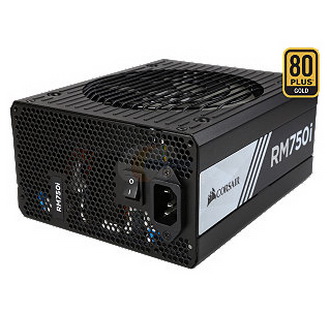Zalman ZM750-EBT PSU Review
Zalman's new EBT line consists of four PSUs ranging from 650W to 1kW capacity. Today, we're testing the ZM750-EBT, which, thanks to a low price, achieves a good value score. But how does it fare in terms of absolute performance?
Why you can trust Tom's Hardware
Load Regulation, Hold-Up Time And Inrush Current
To learn more about our PSU tests and methodology, please check out How We Test Power Supply Units.
Primary Rails And 5VSB Load Regulation
Load Regulation testing is detailed here.
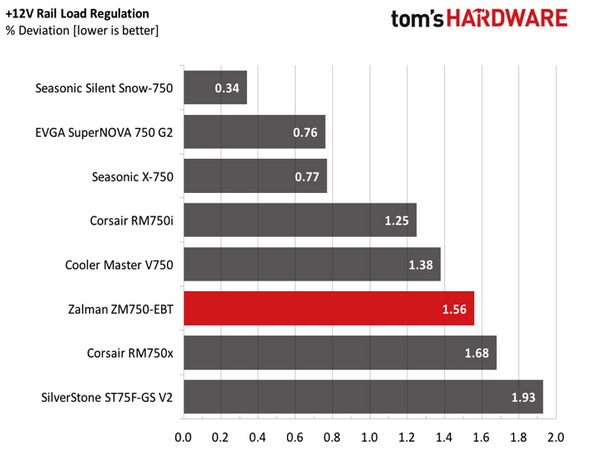







Hold-Up Time
Our hold-up time tests are described in detail here.
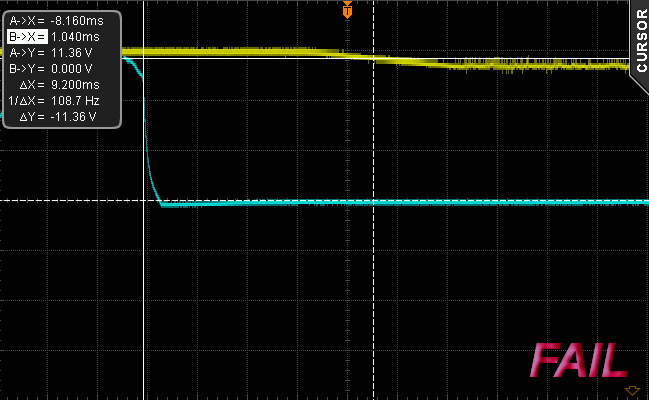
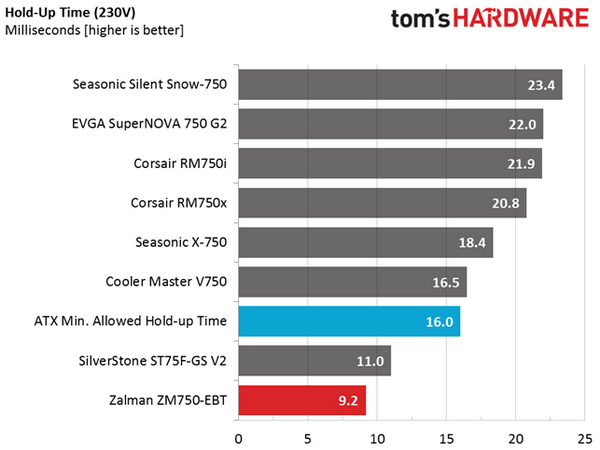
Not only are we measuring the PWR_OK signal (AC loss to PWR_OK hold-up time), but we're also checking when the +12V rail drops below its limit when AC voltage is removed from the PSU.
Our oscilloscope measured only 9.2ms, while the ATX spec requires at least 17ms. In other words, Zalman's PSU fails big time in this test. Meanwhile, the AC loss to PWR_OK hold-up time was extra long, exceeding 27ms. Sirfa uses a nasty trick here, and in the following paragraph, we'll try to explain what it did plainly.
Normally, the PWR_OK signal has to drop to zero volts before any of the rails fall below the corresponding ATX limit. In this case, the PWR_OK signal is kept active for a much longer period. This means that very low DC outputs feed your precious hardware, since the motherboard sees the PSU as active through the PWR_OK signal. In some cases, this can cause damage. Instead of dropping to zero volts while the +12V rail was higher than 11.4V, the ZM750-EBT's PWR_OK dropped while the 12V rail was at just 10.24V!
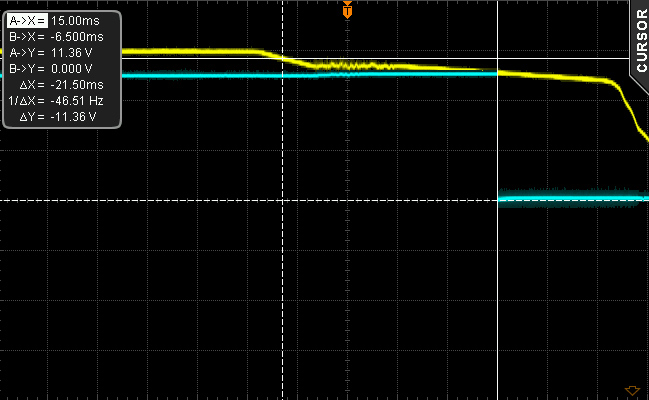

The time difference between the moment when PWR_OK drops to zero and the +12V rail goes out of spec is very large at 15ms. Normally, the PWR_OK signal should drop before the +12V rail goes out of limits, not after.
Get Tom's Hardware's best news and in-depth reviews, straight to your inbox.
Inrush Current
For details on our inrush current testing, please click here.


The inrush current is very high with both 230V and 115V input.
Load Regulation And Efficiency Measurements
The first set of tests reveals the stability of the voltage rails and the PSU's efficiency. The applied load equals (approximately) 10 to 110 percent of the maximum load the supply can handle, in increments of 10 percentage points.
We conducted two additional tests. During the first, we stressed the two minor rails (5V and 3.3V) with a high load, while the load at +12V was only 0.10A. This test reveals whether a PSU is Haswell-ready or not. In the second test, we determined the maximum load the +12V rail could handle with minimal load on the minor rails.
| Test | 12V | 5V | 3.3V | 5VSB | DC/AC (W) | Efficiency | FanSpeed (RPM) | FanNoise (dB[A]) | Temps In/Out (°C) | PF/AC Volts |
|---|---|---|---|---|---|---|---|---|---|---|
| 1 | 4.338A | 1.961A | 1.967A | 0.969A | 74.81 | 82.03% | 1165 | 43.0 | 36.04 | 0.985 |
| 12.268V | 5.102V | 3.352V | 5.153V | 91.20 | 39.86 | 115.0V | ||||
| 2 | 9.707A | 2.937A | 2.962A | 1.165A | 149.72 | 87.29% | 1315 | 45.6 | 37.75 | 0.994 |
| 12.248V | 5.090V | 3.339V | 5.140V | 171.53 | 41.74 | 115.0V | ||||
| 3 | 15.441A | 3.444A | 3.479A | 1.363A | 224.88 | 89.07% | 1375 | 46.3 | 38.63 | 0.997 |
| 12.228V | 5.078V | 3.330V | 5.128V | 252.49 | 42.92 | 115.0V | ||||
| 4 | 21.180A | 3.941A | 3.974A | 1.559A | 299.74 | 89.55% | 1430 | 47.5 | 39.62 | 0.997 |
| 12.210V | 5.068V | 3.318V | 5.115V | 334.73 | 44.22 | 115.0V | ||||
| 5 | 26.601A | 4.946A | 4.992A | 1.760A | 374.75 | 89.42% | 1450 | 48.3 | 40.21 | 0.998 |
| 12.190V | 5.056V | 3.305V | 5.100V | 419.07 | 45.63 | 115.0V | ||||
| 6 | 32.039A | 5.943A | 6.014A | 1.963A | 449.63 | 89.04% | 1550 | 49.8 | 41.30 | 0.998 |
| 12.169V | 5.043V | 3.291V | 5.088V | 504.96 | 47.43 | 115.0V | ||||
| 7 | 37.495A | 6.956A | 7.046A | 2.165A | 524.60 | 88.51% | 1560 | 50.0 | 42.88 | 0.998 |
| 12.149V | 5.030V | 3.278V | 5.073V | 592.68 | 49.64 | 115.0V | ||||
| 8 | 42.969A | 7.972A | 8.084A | 2.370A | 599.51 | 87.78% | 1560 | 50.0 | 44.52 | 0.998 |
| 12.128V | 5.017V | 3.265V | 5.059V | 683.00 | 52.60 | 115.0V | ||||
| 9 | 48.902A | 8.486A | 8.636A | 2.374A | 674.56 | 87.04% | 1560 | 50.0 | 45.26 | 0.998 |
| 12.106V | 5.005V | 3.253V | 5.048V | 775.04 | 55.07 | 115.0V | ||||
| 10 | 54.596A | 9.018A | 9.158A | 2.980A | 749.42 | 85.98% | 1560 | 50.0 | 46.20 | 0.998 |
| 12.084V | 4.991V | 3.242V | 5.028V | 871.59 | 57.66 | 115.0V | ||||
| 11 | 60.901A | 9.036A | 9.180A | 2.986A | 824.23 | 84.81% | 1560 | 50.0 | 47.03 | 0.998 |
| 12.061V | 4.983V | 3.234V | 5.018V | 971.91 | 59.92 | 115.0V | ||||
| CL1 | 0.099A | 14.020A | 14.005A | 0.004A | 118.17 | 81.07% | 1560 | 50.0 | 42.82 | 0.993 |
| 12.240V | 5.049V | 3.295V | 5.136V | 145.76 | 50.44 | 115.1V | ||||
| CL2 | 62.459A | 1.002A | 1.003A | 1.003A | 767.80 | 86.37% | 1560 | 50.0 | 44.71 | 0.999 |
| 12.078V | 5.027V | 3.283V | 5.072V | 889.00 | 55.44 | 115.0V |
Load regulation on the +12V and 5VSB rails is satisfactory for a PSU with this price tag. At 5V it's decent, and 3.3V is on the loose side, exceeding 3% deviation.
As far as efficiency goes, the ZM750-EBT clears our 20 percent test by registering over 87% efficiency. However, it fails to do so in the 50 percent and full load tests. Of course, we run our benchmarks at much higher ambient temperatures than the 80 Plus organization and, in general, those conditions seriously affect efficiency. Still, we've seen other Gold-rated units register much higher efficiency in the same metrics.
Finally, output noise is very high since Sirfa uses an aggressive fan profile. If you dislike fan noise and plan to push your machine hard, this power supply probably won't work for you.
Current page: Load Regulation, Hold-Up Time And Inrush Current
Prev Page A Look Inside And Component Analysis Next Page Efficiency, Temperature And Noise
Aris Mpitziopoulos is a contributing editor at Tom's Hardware, covering PSUs.
-
Onus Although the article does mention safety, a very valid point, it still managed to imply that a single-rail PSU was "better" due to the complexity of managing rail assignments so as to not trip OCP protections. I've have not seen a multi-rail PSU actually get dinged for this in a review for maybe 8-10 years; it seems that everyone does OCP "right," so this is no longer an issue, ever. That being the case, the greater safety of a multi-rail design is superior.Reply
I'll need to make at least another pass through this article, but failing on +5V ripple under heavy load probably makes this a solid tier-3 unit; I'm not going to run screaming if I see one, but I wouldn't buy it either. -
JQB45 Tier-3 might be generous. There were a lot of cons. What good is a 7 year warranty if the PSU takes something else out in addition to the PSU.Reply
CONS: Ripple • Noisy under stress • Hold-up time • Inrush current • Sleeve-bearing fan • Single EPS connector • Inaccurate PWR_OK signal
Also it must also be strongly pointed out that this unit does not meet ATX specifications. -
Onus True, but the tier-3 units are the ones considered solid for lighter loads. Those cons are why I certainly would not buy one for a gaming or rendering rig, but for the typical PC that may not need even half this power, I wouldn't worry about it.Reply -
Sakkura The fact that it's not just barely breaking the ATX spec at 100% load, but already starts to go out of spec at 80% and then has two rails well out of spec at 100%, is what makes this a tier 4 unit, and a clear "do not buy" regardless of price.Reply -
yyk71200 One would expect that a gold rated powersupply would be at least a solid unit and a safe buy. Guess not. Shouldn't buy one simply based on advertised efficiency rating.Reply -
Onus That's definitely true. Coolermaster taught that lesson quite well.Reply
Hmmm, this one does seem a little worse than I thought at first. Any chance this particular unit had a problem? I'd think ripple could be fixed with a minor capacitor improvement, without adding too much to the price. Hopefully Zalman is paying attention. -
JQB45 Reply17328110 said:That's definitely true. Coolermaster taught that lesson quite well.
Hmmm, this one does seem a little worse than I thought at first. Any chance this particular unit had a problem? I'd think ripple could be fixed with a minor capacitor improvement, without adding too much to the price. Hopefully Zalman is paying attention.
agreed -
COLGeek It is interesting to see Zalman developing this line of PSUs. Hopefully, they will be better than previous generations. Had a couple Zalman PSUs a few years ago, when I used to use Zalman heatsinks.Reply
One died days after the warranty expired and the other about a month after. I'll give Zalman credit, they made right by me by exchanging both, but it was a painful process.
While I would not recommend these current products, I can at least "tolerate" them in budget builds. -
turkey3_scratch I would think anything out of spec should be Tier 4. Ripple is trash. 3.3V rail was on the brink of being out of spec. 12V was also quite terrible at 90mv.Reply
Anyway, I like your power supply reviews, Toms. You go more in-depth than any review site for power supplies (Hardwaresecrets, Johnnyguru). -
Sakkura Reply17328110 said:That's definitely true. Coolermaster taught that lesson quite well.
Hmmm, this one does seem a little worse than I thought at first. Any chance this particular unit had a problem? I'd think ripple could be fixed with a minor capacitor improvement, without adding too much to the price. Hopefully Zalman is paying attention.
Considering the same platform performs decently in the Silverstone unit, there's at least some hope that Zalman can go back, adjust a few things, and get a decent budget unit out of this.
Edit: I went back and looked at the Silverstone review. Ripple suppression was really good up to 90% load, then the 5V and 3.3V rails jumped hugely, especially the 3.3V. They did stay within ATX spec, but just barely. The 5V ripple went from 13.1mV at 90% to 40.5mV at 100%, 3.3V ripple went from 14.1mV at 90% to 49.9mV at 100%. Obviously the 3.3V ripple went out of spec at 110% load, as well as one of the crossloads, but that's a lesser sin.


